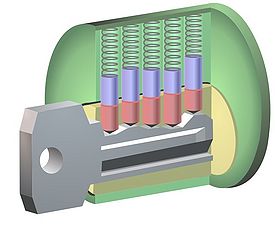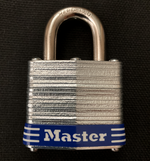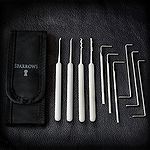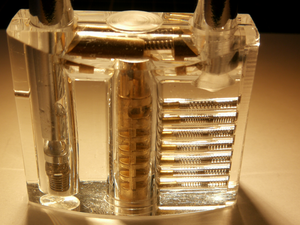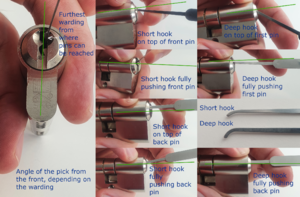Begin pin tumbler: Difference between revisions
m (typos) |
No edit summary |
||
| Line 96: | Line 96: | ||
=== Navigation === | === Navigation === | ||
==== Angling the lock pick ==== | ==== Angling the lock pick ==== | ||
The lock pick often needs to be angled to navigate the lock smoothly. The general idea is that you can move the pick around in the lock without scraping the sides of the pick against the lock, as this can take useful feedback away. This often means the pick needs to be angled clockwise or counterclockwise a few degrees. | [[Image:Angles_smaller.png|thumb|Some pick angles in a Wink Haus lock. Select to enlarge.]] | ||
The lock pick often needs to be angled to navigate the lock smoothly. The general idea is that you can move the pick around in the lock without scraping the sides of the pick against the lock, as this can take useful feedback away. This often means the pick needs to be angled clockwise or counterclockwise a few degrees. See the picture, which illustrates this and other angles. | |||
# An exercise that can help is to insert the pick in the keyway, holding it so lightly it almost slips from your fingers. You will typically see that the pick automatically angles clockwise or counter clockwise, depending on the keyway. This exercise is recommended without using a tensioner at first. | # An exercise that can help is to insert the pick in the keyway, holding it so lightly it almost slips from your fingers. You will typically see that the pick automatically angles clockwise or counter clockwise, depending on the keyway. This exercise is recommended without using a tensioner at first. | ||
| Line 107: | Line 109: | ||
It is possible that the angles differ by even 90 degrees. Note that the pins in the back of the lock require a significant smaller angle. | It is possible that the angles differ by even 90 degrees. Note that the pins in the back of the lock require a significant smaller angle. | ||
==== Feeling where you are ==== | ==== Feeling where you are ==== | ||
Revision as of 11:47, 29 October 2021
|
Getting Started
|
Next Steps
|
Resources
|
|
Beginning Pin Tumbler Picking
CommunityLocksAlthough there seems to be a lot of people beginning their lockpicking training on padlocks, a double deadbolt or a cheap double euro cylinder can be a better choice; by sawing it in halves, you get two training locks. Gut them (just watch for the skeletonized cores!) and you can progressively pin them to learn your way around the keyway. This also saves you pain of learning security pins right at the beginning - just use standard drivers at the start and start adding security pins into the mix when you are ready.
ToolsTo begin to learn Single Pin Picking (SPP), at least two tools are needed: one to manipulate the pins and one to rotate the lock plug. A pick with a hook profile is often recommended for SPP. It is generally recommended to use a turning tool that fits in the keyway without blocking access to the pins while still providing feedback and control of the rotation. Listed here are a few suppliers where hobby lockpickers frequently buy these tools
It is easy to make some tools yourself
Other useful stuff
PracticePractice Locks
ExercisesThe following section provides exercises to help new lock pickers develop their new skills. Like with many other activities, it's recommended to learn good habits from the start instead of unlearning bad habits later. These exercises try to support such a good start. Angling the lock pickThe lock pick often needs to be angled to navigate the lock smoothly. The general idea is that you can move the pick around in the lock without scraping the sides of the pick against the lock, as this can take useful feedback away. This often means the pick needs to be angled clockwise or counterclockwise a few degrees. See the picture, which illustrates this and other angles.
Typically the pick requires an angle of 5 or 10 degrees. Also, in general, pins need to be manipulated without disturbing other pins. This generally means the back of the pick should be as far away from the pins as possible, while the tip is able to manipulate one pin at a time.
It is possible that the angles differ by even 90 degrees. Note that the pins in the back of the lock require a significant smaller angle.
Feeling where you areWhile lock picking it is generally important to know which pin you are touching and, perhaps more importantly, to know if you are touching a pin. One reason picks break with beginners is that by accident the lock itself is pushed by the pick instead of the pin. An excersise that can help with knowing where you are is the following:
PickingTensioningDifferent levels of tension on the lock make a big difference in picking. A lot of tension makes the feedback of the lock more clear, but moving the pins precisely hard. Very light tension makes it easy to manipulate the pins but can make it difficult to detect feedback (for example, without accidentally manipulating the pins). In the end it's all about the lock and tension needs to be adjusted depending on the situation. The following exercises are intended to give an initial idea of the range of tension. Minimum tension
Tension on the binding pinFor this exercise it helps, if you have one, to set your practice lock up with only one pin chamber (only one key pin, driver pin and a spring). Without a practice lock, remember and apply the exercise to the speed bump pin of the previous exercise.
Tool CheckDisassembly
OR
Books
|
